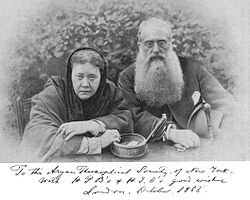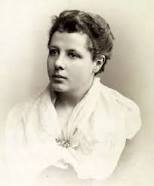Whilst writing Shell Shocked Britain: The First World War’s legacy for Britain’s mental health, I became fascinated with the rejuvenation of the Spiritualist movement just before, during and after the Great War, on into the 1930s. People were so fascinated by the chapter in the book that dealt with the subject that I pitched an idea for another book to deal specifically with that subject, and how bereaved families turned to mediums and the spiritualist church in their thousands as a response to grief. That book has been commissioned and I am thrilled to have the chance to do more research on the subject.
Someone who has been a huge support to me as I try to find out more is Ian Stevenson, who has written on this blog twice before, most recently in response to a piece I wrote on spiritualism to highlight how people dealt with the psychological trauma of war. So, when I expressed some confusion about ‘theosophy’and its relationship to spiritualism, he offered to clarify things for me and I thought readers of my blog might be interested too… Here is a summary of his thoughts:

Theosophy means ‘The wisdom of the Gods’, and the Theosophical Society in England describes it as ‘the thread of truth in scriptures, creeds, symbols, myths and rituals. ‘ It is usually used to refer to teachings of the Theosophical Society founded in New York in 1875 by an American, Henry Olcott and a Russian noblewoman Helena Petrovna Blavatsky, usually called Madam Blavatsky, or HPB. Olcott was a Spiritualist but Blavatsky claimed to be a medium with psychic abilities and beliefs that caused disagreement with the Spiritualist Church. In her view mediums did not usually contact the real person who had died but a ‘shade’. In her view, once on the other side, the essential person began a process of life evaluation and progress to a new life. The personality of the life just left separated and became a shade. It could respond with the memory and characteristics of the deceased but it was not the real, essential person. After a while, it even lost the power to communicate and became a shell which drifted and eventually disintegrated. This did not go down well with the Spiritualists, who grappled with her controversial and often inconsistent views.
We think of the Victorian age as one of faith. In fact there were growing doubts and a survey in 1851 found that only half the population attended church-and that was a day the clergy did their best to ensure good attendance. The urban working class were the worst at attending church. The poem Dover Beach by Matthew Arnold, published in the 1860s but probably composed earlier, refers to an ebbing of faith common to may intellectuals of the time. Blavatsky believed the mainstream churches had lost deeper understanding of their faith and all people had were the doctrines, preached without real understanding.The motto of the Theosophical Society is: “there is no religion higher than truth”, or that behind all the different faiths was a single reality, which could not be understood by reason alone.
The Theosophical Society has three aims or objects:
- To form a nucleus of the ‘Universal Brotherhood of Humanity’ without distinction of race, creed, sex, caste or colour.
- To encourage the study of Comparative Religion, Philosophy and Science.
- To investigate unexplained laws of Nature and the powers latent in man.

The Society played a major part in bringing Eastern thought to the West and providing alternatives to the Christian monopoly of religious thought. Many of the concepts of the New Age movement which flourished in the 1960s onwards, were first introduced by the Society. A key concept of Theosphism is that of re-incarnation and karma, along with the hidden or occult world and such ideas as astral planes and mental planes of existence. Blavatsky wrote a number of books, notably The Secret Doctrine, which influenced great names such as William Butler Yeats, Frank Baum (author of the Wizard of Oz), Paul Gauguin, Kandinsky, Klee, and Mahler. The emphasis on brotherhood and treating women as equals was, for its time, quite revolutionary, and in Britain an early leader was Annie Besant, prominent women’s rights activist and socialist, who married a clergyman. After reading the four gospel accounts of the crucifixion decided she could not believe in the inspired nature of the Bible and refused to take communion despite being ordered by her husband, from whom she later separated, to do so.
In 1920 Theosophy was debated at the Lambeth Conference, which the Anglican Church holds every ten years, along with Christian Science and Spiritualism. Of course, they could not approve of these movements. Many resolutions condemned them. Others, however, felt that they should, at least, be taken seriously. But there was no real attempt to create dialogue and today the church will speak with other mainstream religions but has little contact with alternative spiritual movements.
By the 1960s, other strands of spiritual thought were emerging e g. Transcendental meditation or Zen. The emphasis of the New Age was on ‘bottom up’ spirituality and the individual finding their own path, drawing on ancient traditions, such as Gnostic Christianity and modern movements, such as the psychology of Carl Jung as well as modern science. The Theosophical Society has a more dynamic presence in the USA and the British sections have declined, though not disappeared.
My thanks to Ian for drawing my attention to the importance of Theosophy to our recent increased need to find a more spiritual path via meditation and mindfulness. It is a complex subject but I will look at the photos and discussions about Madame Blavatsky as a medium with greater interest and understanding of her motives. It is easy to call all mediums ‘frauds’ (Stephen Fry even called them that directly through the cameras of QI XL this week….) but some genuinely felt they had a gift, and a connection to whatever constitutes ‘the other side’. I am looking forward to examining the subject in more detail in my book!


I came across the case of a conscientious objector in Twickenham whose Theosophist beliefs were given as the main reason for his objection to combat. I’ll see if I can dig the record out, I made a lot of notes about it and have been meaning to look more into the case.
Thank you – that would be great.It is a fascinating subject.
Reblogged this on bookpino.
Your comment on belief in mediumistic powers: Houdini famously fell out with Conan Doyle because the latter remained convinced that despite his frequent debunking of fake mediums, Houdini himself was an ‘unconscious’ medium who would not acknowledge his own gift. I’ve written (very superficially!) about this at http://bit.ly/1DZkTNh
Thank you – I will go over and take a look 🙂 The relationship between those ‘celebrities’ who had an interest in spiritualism is an interesting area of research I want to focus on.
You may already know all this but
Historians often link the rise of Spiritualism in the US to deaths in the Civil War: http://books.google.com/books/about/This_Republic_of_Suffering.html?id=0Ng-hNXC1P0C
And there’s a whole a book on William James & the Society for Psychical Research’s search for life after death: http://www.amazon.com/Ghost-Hunters-William-Search-Scientific/dp/0143038958
Like brother Henry, William spent much time in England. He was also deeply interested in Eastern religions, especially Buddhism. Henry & William’s father was a Swedenborgian. Swedenborgianism was to some extent to the first half of the 19th century what Theosophy was to the second half, in the sense of being an alternative to conventional religion for self-defined “seekers”.
On Madame Blavatsky, the book “Madame Blavatsky’s Baboon” by Peter Washington is snarky but memorably vivid & gives wonderful overview of fringe religious culture in 19th & 20th century English-speaking world. http://www.amazon.com/Madame-Blavatskys-Baboon-History-Spiritualism/dp/0805210245
Olcott & Blavatsky met while investigating alleged psychic phenomena on a Vermont farm. He remained in India after Blavatsky left, & was a major figure in the revival of the Theravada school of Buddhism.
BTW, Spiritualism was one of several movements to come out of the “Burned-Over District” of western New York State: http://en.wikipedia.org/wiki/Burned-over_district. And the first woman to run for president of the US was a spiritualist with a *very* colorful past: http://en.wikipedia.org/wiki/Victoria_Woodhull.
Hope this isn’t an overload of unasked for information — alternative culture in the 19th & 20th centuries is a long-standing interest of mine.
This is so interesting and useful – thank you so much for taking the time to reply. I will make sure I follow up all these leads 🙂
Abraham Lincoln was persuaded to have mediums come to the White House. Afterwards he was asked whether they had given him guidance on how to fight the Civil War. ‘Well.’ he said, ‘they are like my generals. They all give me conflicting advice.’
People often dismiss ‘spirit communications’ on the grounds they don’t offer the answer to God, the Universe and Everything. The Spiritualists would say, we are still the same people when we pass over-although we gradually evolve.
An interesting blog. On Twitter I sent you details of a Radio play about spiritualism around WW1. Personally, I have no doubt about the continuation of life and I have seen and know some excellent mediums. It is important to remember that, as in all walks of life, there are some better than others and some not to be trusted very often, if at all. I would dismiss Stephen Fry as one with a ‘closed mind’, even though he might state otherwise. Even he could be surprised! Good luck with your research and book. I hope that it will show those who ‘believe’ in a positive light.
It is a shame we can’t access that radio play but I will keep on looking. It is such an interesting area to research and I am certainly going into it with an open mind.
You should read the autobiography of Mary Lutyens, To Be Young. Her mother became an active participant in the Theosophy movement and Mary was drawn into some key moments in its history.
Your post brings me back to Pat Barker’s Regeneration trilogy…and now I want to pick up your book. Looking forward to the rest of your blog…
brianjkelley.net